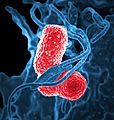Klebsiella pneumoniae facts for kids
Quick facts for kids Klebsiella pneumoniae |
|
|---|---|
 |
|
| K. pneumoniae on a MacConkey agar plate. | |
| Scientific classification | |
| Kingdom: | |
| Phylum: | |
| Class: | |
| Order: | |
| Family: | |
| Genus: |
Klebsiella
|
| Species: |
K. pneumoniae
|
| Binomial name | |
| Klebsiella pneumoniae (Schroeter 1886)
Trevisan 1887 |
|
Klebsiella pneumoniae is a tiny living thing, a type of bacterium, that belongs to a group called Klebsiella. These bacteria are often found naturally in places like your mouth, skin, and intestines without causing any problems. However, they can sometimes cause serious infections, especially a type of lung infection called pneumonia. Like many other bacteria, Klebsiella pneumoniae is known as 'gram-negative' because of how it looks under a microscope after a special test.
Contents
What is Klebsiella pneumoniae?
Klebsiella pneumoniae is a common type of bacterium. It is shaped like a rod and is usually found in many different environments. These include soil, water, and even inside humans and animals. It's part of a larger family of bacteria called Enterobacteriaceae.
Where do these bacteria live?
- In humans, Klebsiella pneumoniae often lives harmlessly in the gastrointestinal tract, which includes your intestines.
- It can also be found on the skin and in the mouth.
- Outside the body, it lives in soil and water. This means it's quite common in our environment.
How do we identify Klebsiella pneumoniae?
Scientists use special tests to identify Klebsiella pneumoniae.
- One common test is the Gram stain. This test helps classify bacteria based on their cell wall. Klebsiella pneumoniae is a 'gram-negative' bacterium. This means it does not hold a certain purple dye after the test.
- Another way to identify it is by growing it in a lab. When grown on a special plate called MacConkey agar, it often forms large, sticky colonies. These colonies can look pink or red.
Infections caused by Klebsiella pneumoniae
While often harmless, Klebsiella pneumoniae can cause various infections. These infections usually happen when the bacteria get into parts of the body where they don't normally belong.
Pneumonia and other lung infections
- The most well-known infection caused by Klebsiella pneumoniae is pneumonia. This is a serious lung infection that makes it hard to breathe.
- It can cause symptoms like fever, chills, and a cough.
- This type of pneumonia is often more severe than other forms. It can lead to lung damage.
Other common infections
- Urinary Tract Infections (UTIs): These bacteria can cause infections in the urinary tract, including the bladder and kidneys.
- Bloodstream Infections: If the bacteria enter the bloodstream, they can cause a serious condition called sepsis. Sepsis is a life-threatening response to infection.
- Wound Infections: Klebsiella pneumoniae can infect wounds, especially in people who have had surgery.
- Meningitis: In rare cases, it can cause meningitis, which is an infection of the membranes around the brain and spinal cord.
Treating Klebsiella pneumoniae infections
When Klebsiella pneumoniae causes an infection, doctors usually treat it with antibiotics. Antibiotics are medicines that kill bacteria or stop them from growing.
The challenge of antibiotic resistance
- One big problem with Klebsiella pneumoniae is that it can become resistant to antibiotics. This means the antibiotics no longer work against the bacteria.
- Some strains of Klebsiella pneumoniae are called 'multidrug-resistant'. This means they are resistant to many different types of antibiotics.
- This resistance makes infections much harder to treat. Doctors have to use stronger or different types of antibiotics.
- Scientists are working hard to find new ways to fight these resistant bacteria.
How to prevent infections
- Good hygiene: Washing hands often with soap and water is very important. This helps stop the spread of germs.
- Clean environments: Keeping hospitals and other healthcare settings clean helps prevent infections.
- Careful use of antibiotics: Only using antibiotics when truly needed helps slow down resistance.
Images for kids
See also
 In Spanish: Klebsiella pneumoniae para niños
In Spanish: Klebsiella pneumoniae para niños




